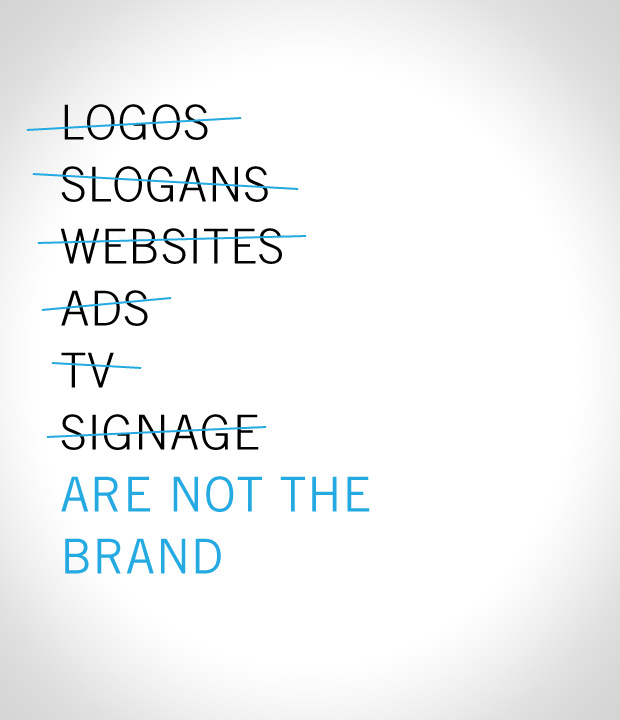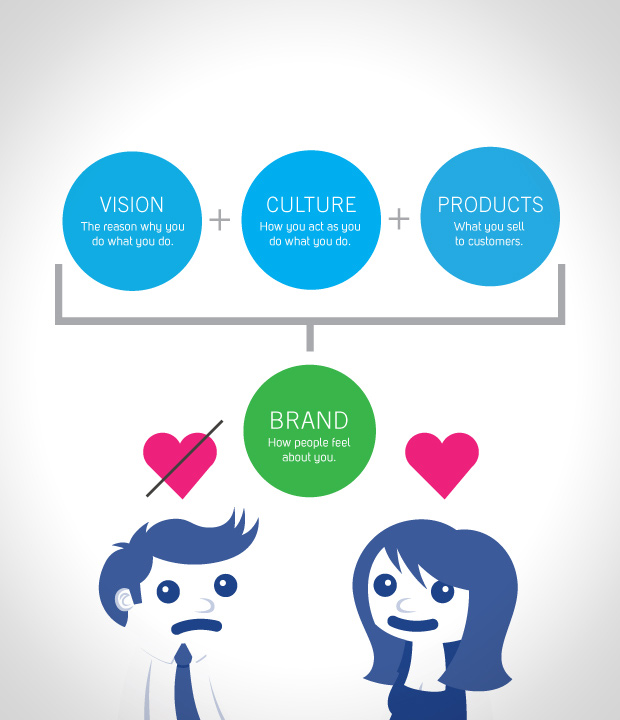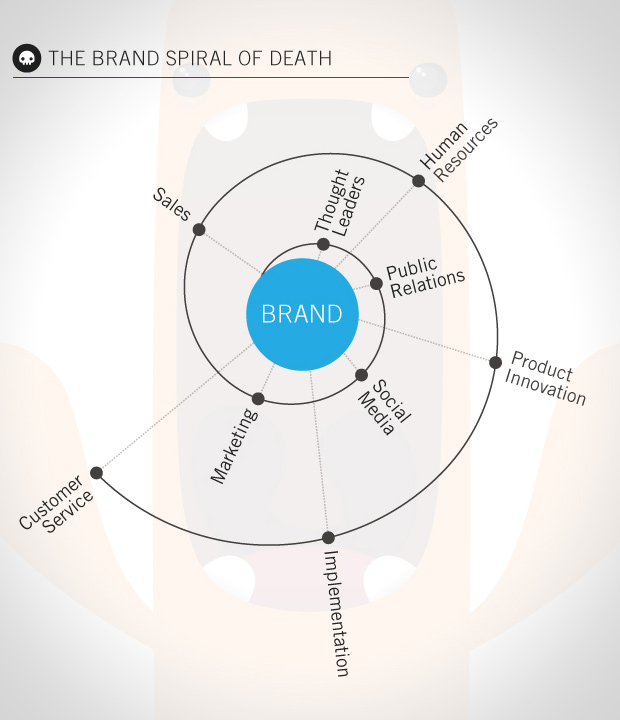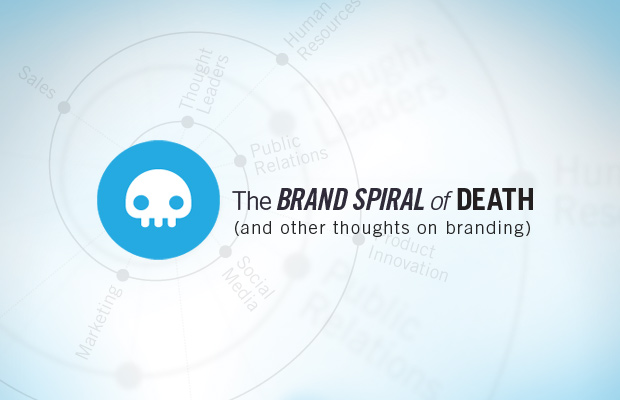The Brand Spiral of Death (and Other Thoughts on Branding)
The importance of branding from the inside out.
There are two things you need to understand about your brand:
- You care about it more than your customers do
- You can change that
In order to begin the shift to a brand that customers genuinely care about, it’s critical to understand that branding is the starting point. Not marketing. Not sales. Branding. Yes, that 8-letter word that agencies and clients have been carelessly throwing around for years in an attempt to sound smarter than one another.
With this in mind, let’s clarify our terminology:
Brand is the internal and external perception of a company or its products.
Branding is the act of defining how customers should feel about a company or its products (the brand promise), and the use of strategy and tactics to shape the way they actually feel about that company or its products.

Logos and slogans, print and online communications are not the brand. These elements may serve as reminders and reinforcement, but the brand itself is what develops in the minds of people when they see those artifacts.
Branding is dependent on marketing to shape perceptions, and marketing is dependent on the brand promise to define what shape it is trying to promote. Without a brand promise, marketing has no message, no purpose. Without purpose, the effectiveness of marketing is diminished. Materials will have nothing to say or connect to, and the resulting impression will extend to the overall brand.

Much in the way the brand promise drives marketing, it should also drive sales, product development, PR, HR and customer service teams. It should drive the entire culture. In fact, the soul of a brand is the culture that lives, breathes and exudes its promise every day. The brand makes the culture and the culture makes the brand. So it’s necessary to understand the impact that branding has on company culture, and thus the impact that culture has on external audiences.
The majority of companies who engage Atomicdust, come to us looking like this. We call it the “brand spiral of death”. Shown here is a brand promise that for any number of reasons lacks the gravity needed to create a strong, consistent, homogenous culture around it.

The result? The teams who remain closest to the brand promise have the least amount of influence over potential and existing customers (although they have the greatest amount over culture). The teams who tend to drift the furthest from understanding/living the brand promise, however, have the most contact with customers. This leads to organizational challenges internally and an unfavorable brand experience for the external world as well.
How do you prevent this? You can’t, entirely.
This should be the part where I show a diagram with a compelling brand promise holding the departments in a perfect, circular orbit, but… People will be people, and the larger organizations and teams get, the more challenging it becomes to build a consistent culture that is 100% true to the brand all the time.
However, you can create such a captivating, genuine, believable brand promise that you inspire a culture that is much more likely not to stray from its core values. Then, you can propagate and manage the brand in such a way that this is sustainable. This not only gives you much more control over the ‘spiral’, but it also serves as the first step in making the transition to a brand that your customers deeply care about…even more than you do.
The best place to start looking for this is within internal teams. We call this an audit. And an audit fuels:
- Perspective: Branding strategy cannot be outsourced, but it can usually be found outside of the select few who ‘run’ an organization. When a company hires Atomicdust, it is to help extract the hidden answers that lie buried in internal politics, departmental/personal goals, job titles and proximity to products and services. We strive to uncover the truths about the organizations we work with, not to invent new ones. What better way to do so than by exploring the personalities throughout the organization? It is amazing what you can learn from 15 60-minute private conversations, shocking to see where individuals from different departments are in alignment and where there is dissent (on subjects as simple as the description of what a company does, for instance), and empowering to find insights in the least expected places that can forever change an organization.
- Adoption: While the insight gained in this process is invaluable, there is another benefit of including internal teams.Through their involvement in the process of shaping the brand, they will feel more connected to the solution. They will see themselves reflected in the core values and surrounding messaging. They will become some of the greatest assets in affecting their teams and thus assimilating the brand into the culture.
When approaching branding, there is an advantage in applying a proven, repeatable process. The theory is that a process with little variation will produce results with little variation, and thus produce consistent solutions time and time again. Consistency in methodology is a key factor, but it’s important that the process be effective in the first place. Those which take a critical look through the lenses of internal and external stakeholders (as noted above), competitive positioning, past and current marketing efforts and language usage are digging in the right places.
See, at its core, branding is a process of reconciliation. Of harmonizing an existing perception with a new vision. Even when branding a new company or product, there are preconceptions to consider around industry, geography, price, target audience and more. The right process will pull the right information from the right sources to inform the new strategy and supporting messaging.
Once a the brand promise has been defined, its values outlined and story clearly articulated, they must be communicated. And this communication starts within an organization. It’s not just about adoption, it’s about engraining the philosophy into the culture of the company. Employees need to understand that if they don’t believe, live and try to shape the preferred brand perception that has just been laid out, then the outside world will form an alternative perception. Marketing can produce a new mountain of message-based materials to support the internal and external launches, but if the rest of the company isn’t aligned, the brand is likely to end up in the same spiral of death it just spent a small fortune getting out of.
When a culture is aligned with a brand, though, amazing things happen.
Everyone is on the same page. There is a sense of community, continuity and connection. The leadership of the organization has a compelling, inspirational story to tell. That story unifies departments throughout the company with direction and purpose. Products become better. Marketing is truly supporting sales. Support teams become not only the answer to occasional problems, but, more importantly, one of the greatest assets to a brand. They are the final living testament that the product or service customers believed in enough to purchase is all that they hoped for. The brand promise is upheld from the beginning of the customer relationship – which often starts before the organization even realizes – until long after the sale has been made.
It’s this consistency, driven by a promise that is meaningful to customers, that helps establish a brand as something that is truly loved instead of spiraling out of control.


